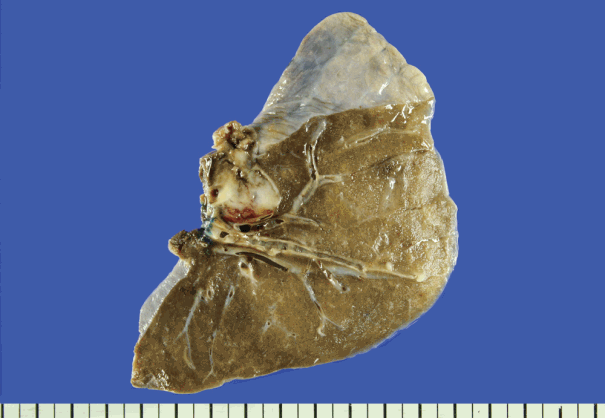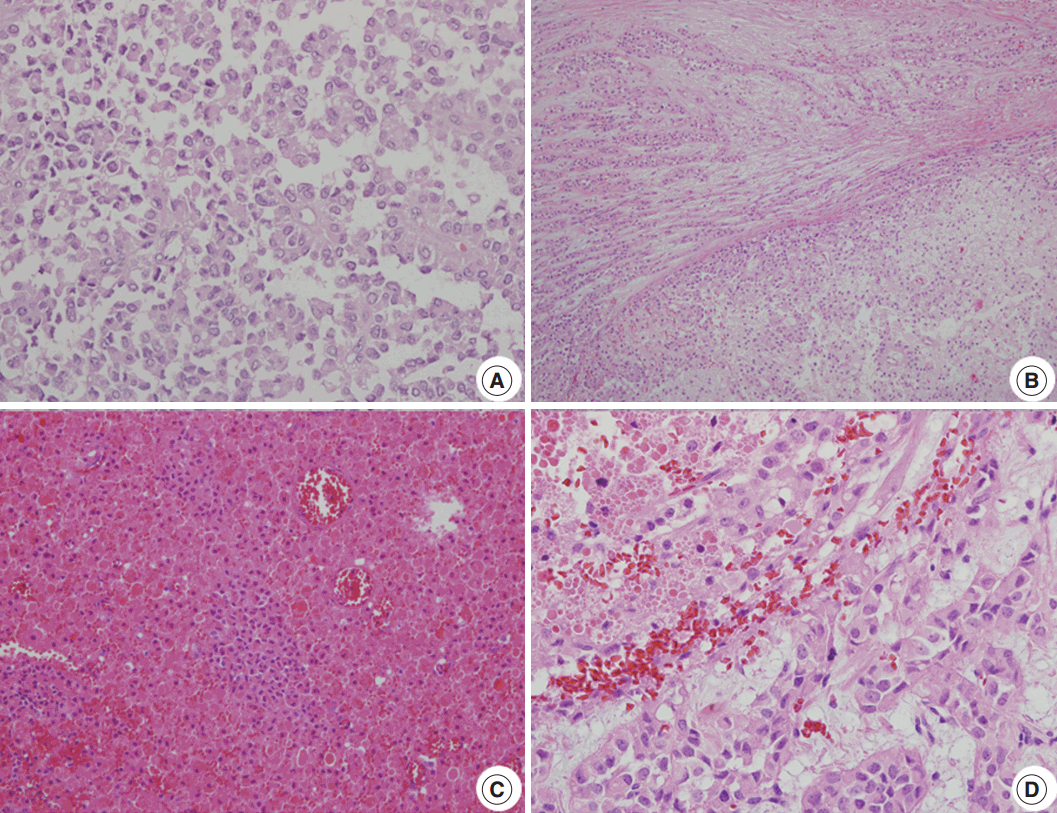Articles
- Page Path
- HOME > J Pathol Transl Med > Volume 51(1); 2017 > Article
-
Case Study
A Rare Case of Recurrent Metastatic Solid Pseudopapillary Neoplasm of the Pancreas - Hye Seung Lee, Han Kyeom Kim, Bong Kyung Shin, Jin Hyuk Choi, Yoo Jin Choi, Ha Yeon Kim
-
Journal of Pathology and Translational Medicine 2017;51(1):87-91.
DOI: https://doi.org/10.4132/jptm.2016.06.16
Published online: August 6, 2016
Department of Pathology, Korea University Guro Hospital, Seoul, Korea
- Corresponding Author Bong Kyung Shin, MD, PhD Department of Pathology, Korea University Guro Hospital, Korea University College of Medicine, 148 Gurodong-ro, Guro-gu, Seoul 08308, Korea Tel: +82-2-2626-1472 Fax: +82-2-2626-1486 E-mail: tabrega@korea.ac.kr
• Received: March 30, 2016 • Revised: May 21, 2016 • Accepted: June 16, 2016
© 2017 The Korean Society of Pathologists/The Korean Society for Cytopathology
This is an Open Access article distributed under the terms of the Creative Commons Attribution Non-Commercial License (http://creativecommons.org/licenses/by-nc/3.0/) which permits unrestricted noncommercial use, distribution, and reproduction in any medium, provided the original work is properly cited.
Figure & Data
References
Citations
Citations to this article as recorded by 

- A rare case of a large solid pseudopapillary neoplasm with extensive liver metastasis
Jun Hyung Kim, Hyung Sun Kim, Jung Min Lee, Ji Hae Nahm, Joon Seong Park
Annals of Hepato-Biliary-Pancreatic Surgery.2025; 29(1): 83. CrossRef - Curative Resection for Metastatic Solid Pseudopapillary Neoplasm of Pancreas—a Case Series
Aparna M. Jagannathan, Manbha L. Rymbai, Abhilasha Anand, Anoop Paul, Borna Das, Thomas Alex Kodiatte, Frederick L. Vyas, Ravish Sanghi Raju, Philip Joseph
Indian Journal of Surgical Oncology.2024; 15(S2): 232. CrossRef - Malignant Solid Pseudopapillary Neoplasm of the Pancreas: An Orthogonal Analysis
Andrew M. Fleming, Leah E. Hendrick, Danny Yakoub, Hafeez Abdelhafeez, Jeremiah L. Deneve, Max R. Langham, Evan S. Glazer, Andrew M. Davidoff, Nipun B. Merchant, Paxton V. Dickson, Andrew J. Murphy
Annals of Surgical Oncology.2024; 31(1): 475. CrossRef - A Unique Presentation of Solid Pseudopapillary Neoplasm of the Pancreas Requiring Pancreaticoduodenectomy Without Pancreatojejunostomy: A Case Report and Literature Review
Alexis L Carmona, Sameh A Fayek
Cureus.2024;[Epub] CrossRef - Case report: Clinical analysis and literature review of five cases of metastatic solid pseudopapillary tumor of the pancreas
Run Hu, Renjie Gui, Xi Nie, Huaxin Duan
Frontiers in Oncology.2024;[Epub] CrossRef - Case of Treatment of Solid Pseudopapillary Pancreatic Tumor
F. S. Rakhimova, N. D. Mamashev, O. A. Shimkina, B. Kh. Bebezov
Creative surgery and oncology.2023; 13(2): 178. CrossRef - Diagnosis and treatment of solid pseudopapillary neoplasm of the pancreas in children: A report of 18 cases
Ayiguzaili Maimaijiang, Haiyun Wang, Wanfu Li, Yaqi Wang
Frontiers in Pediatrics.2022;[Epub] CrossRef - Large tumor size, lymphovascular invasion, and synchronous metastasis are associated with the recurrence of solid pseudopapillary neoplasms of the pancreas
Goeun Lee, You-Na Sung, Sung Joo Kim, Jae Hoon Lee, Ki-Byung Song, Dae Wook Hwang, Jihun Kim, Sang Soo Lee, Song Cheol Kim, Seung-Mo Hong
HPB.2021; 23(2): 220. CrossRef - Solid-Pseudopapillary Neoplasm of the Pancreas: A 63-Case Analysis of Clinicopathologic and Immunohistochemical Features and Risk Factors of Malignancy
Hongchun Chen, Yuchen Huang, Ningning Yang, Wentian Yan, Ruxue Yang, Shan Zhang, Panpan Yang, Nan Li, Zhenzhong Feng
Cancer Management and Research.2021; Volume 13: 3335. CrossRef - Minimally Invasive Approach for Pancreatic Solid Pseudopapillary Neoplasm and Initially Undiagnosed Slowly Progressing Liver Tumor
Shohei Takaichi, Yoshifumi Iwagami, Shogo Kobayashi, Yoshito Tomimaru, Hirofumi Akita, Tadafumi Asaoka, Takehiro Noda, Kunihito Gotoh, Masaki Mori, Yuichiro Doki, Hidetoshi Eguchi
Pancreas.2020; 49(8): e70. CrossRef - Rare Solid Tumor of the Exocrine Pancreas: A Pictorial Review
Marco Dioguardi Burgio, Maxime Ronot, Valérie Vilgrain
Seminars in Ultrasound, CT and MRI.2019; 40(6): 483. CrossRef - The Stomach: a Rare Site for Metastatic Solid Pseudopapillary Neoplasm of the Pancreas
Prajwala S. Prakash, Dexter Yak Seng Chan, Krishnakumar Madhavan
Journal of Gastrointestinal Surgery.2018; 22(4): 759. CrossRef - European evidence-based guidelines on pancreatic cystic neoplasms
Gut.2018; 67(5): 789. CrossRef
 PubReader
PubReader ePub Link
ePub Link-
 Cite this Article
Cite this Article
- Cite this Article
-
- Close
- Download Citation
- Close
- Figure
A Rare Case of Recurrent Metastatic Solid Pseudopapillary Neoplasm of the Pancreas


Fig. 1. Gross specimen of the patient’s lung metastasis. A solid, well-demarcated and cystic mass with hemorrhage is seen.
Fig. 2. Microscopic findings. (A) A loosely cohesive pseudopapillary pattern. (B) Capsular invasion with a cord or glandular pattern is visible in the intermediate and late metastatic lesions. (C) Necrobiotic nests are present in the intermediate lesions. (D) Distinct nuclear atypia is seen in the late lesions.
Fig. 1.
Fig. 2.
A Rare Case of Recurrent Metastatic Solid Pseudopapillary Neoplasm of the Pancreas
| Operation No. | Recurrence interval (mo) | Site | Size (largest diameter) (cm) | Necrobiotic nests | Necrosis | Capsular invasion | Ki-67 labeling index (%) | Solid architecture | Nuclear atypia | Mitotic count (/10HPF) |
|---|---|---|---|---|---|---|---|---|---|---|
| 1 | 0 | Pancreas | 8 | NE | NE | NE | NE | NE | NE | NE |
| 2 | 107 | Liver, peritoneum | 5.5 (liver) | N | N | N | < 0.1 | N | N | < 1 |
| 3 | 131 | Omentum, peritoneum | 4.3 (peritoneum) | N | N | N | < 0.1 | N | N | < 1 |
| 4 | 135 | Peritoneum | 1.3 | Y | N | N | < 0.1 | N | N | < 1 |
| 5 | 180 | Peritoneum | 3.5 | N | N | Y | 0.2 | N | N | 5 |
| 6 | 197 | Peritoneum | 5 | N | N | Y | 5 | N | N | < 1 |
| 7 | 205 | Liver, spleen, peritoneum, ovary | 10 (ovary) | Y | Y | N | 2.9 | N | N | 2 |
| 8 | 214 | Uterus, peritoneum, retroperitoneum, omentum, mesocolon, intrathoracic | 3.8 (intrathoracic) | N | Y | N | 12.4 | Y | N | < 1 |
| 9 | 240 | Peritoneum, mesocolon, colon | 1.5 (colon) | N | Y | Y | 6.6 | Y | Y | < 1 |
| 10 | 272 | Spleen, retroperitoneum | 3.5 (retroperitoneum) | N | Y | Y | < 0.1 | Y | Y | < 1 |
| 11 | 284 | Lung, internal mammary soft tissue | 2.8 (lung) | N | N | N | 3.4 | Y | Y | < 1 |
| Reference | Sex | Age (yr) | Primary site | Size (cm) | Malignant histologic features | Metastasis | Operation | RI (mo) | Recurrence site | Follow-up (mo) | Survival | Mitoses (/10HPF) | Ki-67 (%) |
|---|---|---|---|---|---|---|---|---|---|---|---|---|---|
| Takahashi et al. (2005) [5] | F | 41 | Tail | 12 | Capsule invasion, necrobiotic nests, venous invasion | Liver (multiple) | Distal pancreatectomy, metastatectomy | 14 | Liver, multiple (14 mo); liver, multiple (27 mo); liver, multiple (38 mo); lung, single (41 mo) | 60 | Alive | 5 | 10 |
| Hosokawa et al. (2014) [3] | F | 24 | Head | 6 | Capsule invasion, per pancreatic tissue | PV, SMA, lung | PPPD, PV, resection, pulmonary resection | None | None | 34 | Alive | - | 1.5 |
| Xu et al. (2015) [4] | F | 42 | Body | 13 | NE | Liver, lung, bone | NE | NE | NE | NE | NE | NE | NE |
| Our case (2016) | F | 37 | Head | 8.6 | Capsule invasion, necrobiotic nests, lymphatic invasion, lymph node invasion | None | PPPD | 107 | Liver, spleen, abdominal mesentery, mesocolon, retroperitoneum, ovary, uterus, lung, thoracic cavity | 284 | Alive | 2 | 5 |
Table 1. Clinicopathological data of the patient
HPF, high power field; NE, not evaluable; N, absent; Y, present.
Table 2. Cases of solid pseudopapillary neoplasm with lung metastasis
RI, recurrence interval; HPF, high power field; F, female; PV, portal vein; SMA, superior mesenteric artery; PPPD, pylorus-preserving pancreaticoduodenectomy; NE, not evaluable.

 E-submission
E-submission






